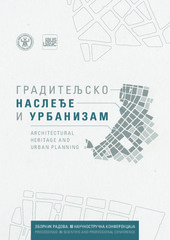Приказ основних података о документу
Заједнички простори као угрожен сегмент архитектонског стамбеног наслеђа из друге половине 20 века
Common areas as an endangered part of the architectural residential heritage from the second half of the 20th century
| dc.creator | Бранков, Борјан | |
| dc.creator | Манић, Божидар | |
| dc.date.accessioned | 2021-10-19T07:12:49Z | |
| dc.date.available | 2021-10-19T07:12:49Z | |
| dc.date.issued | 2021 | |
| dc.identifier.isbn | 978-86-6100-000-3 | |
| dc.identifier.uri | https://raumplan.iaus.ac.rs/handle/123456789/620 | |
| dc.description.abstract | Током друге половине двадесетог века у Југославији је била веома развијена пракса архитектонских конкурса за стамбене блокове и нова насеља. Највећи интензитет станоградње био је у великим градовима и престоници Београду, где су понуђена и примењена иновативна архитектонска и урбанистичка решења организације простора допринела побољшању комфора становања и квалитета живота становника. Архитектонска решења вишепородичних стамбених блокова централне зоне Новог Београда истичу се квалитетом организације полуприватног и приватног животног простора и представљају значајно наслеђе модерног периода у Србији. У тим решењима се поред флексибилности станова и других унапређења склопа истиче и развој заједничких простора (унутар објекта и изван њих). Ти заједнички простори понудили су измештање првенствено колективних функција ван стана и створили додатни простор за активности станара блокова. У раду се истражује како ти простори могу допринети квалитету стамбеног наслеђа блока и какве су разлике између појединих блокова у том погледу и по питању типологије објеката вишепородичног становања. Истраживање кроз примере Блокова 22 и 29 на Новом Београду представља различите заједничке просторе у стамбеним блоковима. | sr |
| dc.description.abstract | During the second half of the twentieth century Yugoslavia had very productive practice of architectural competitions for housing complexes. The highest intensity of housing construction was in large cities, especially in the capital of Belgrade, where innovative architectural and urban design of spatial organization contributed to the improvement of housing comfort and quality of life of residents. The architectural projects of the residential blocks of the central zone of New Belgrade stand out with the quality of the organization of semiprivate and private living spaces and represent a significant heritage of the modern period in Serbia. In addition to the achieved flexibility of dwellings among other improvements in multifamily housing the design of common areas (indoor and outdoor) had its advancement. These common areas offered a potential expansion of collective functions outside the dwelling and an additional space for the activities of the residents of the blocks. The paper examines how these spaces can contribute to the quality of the residential heritage of the block and how specific blocks differ from each other in terms of the typology of multi-family housing. Through the examples of Blocks 22 and 29 in New Belgrade, the research presents the different common spaces in residential multi-family complexes. | sr |
| dc.language.iso | sr | sr |
| dc.publisher | Београд : Завод за заштиту споменика културе града Београда | sr |
| dc.relation | info:eu-repo/grantAgreement/MESTD/inst-2020/200006/RS// | sr |
| dc.rights | openAccess | sr |
| dc.source | Зборник радова: XI Научностручна конференција Градитељско наслеђе и урбанизам (Proceedings: XI Scientific and professional conference Architectural heritage and urban planning) | sr |
| dc.subject | вишепородично становање | sr |
| dc.subject | Нови Београд | sr |
| dc.subject | заједнички простори | sr |
| dc.subject | Блок 22 | sr |
| dc.subject | Блок 29 | sr |
| dc.subject | multifamily housing | sr |
| dc.subject | New Belgrade | sr |
| dc.subject | common areas | sr |
| dc.subject | Block 22 | sr |
| dc.subject | Block 29 | sr |
| dc.title | Заједнички простори као угрожен сегмент архитектонског стамбеног наслеђа из друге половине 20 века | sr |
| dc.title | Common areas as an endangered part of the architectural residential heritage from the second half of the 20th century | sr |
| dc.type | conferenceObject | sr |
| dc.rights.license | ARR | sr |
| dcterms.abstract | Brankov, Borjan; Manić, Božidar; Zajednički prostori kao ugrožen segment arhitektonskog stambenog nasleđa iz druge polovine 20 veka; | |
| dc.citation.spage | 94 | |
| dc.citation.epage | 105 | |
| dc.citation.rank | M63 | |
| dc.description.other | Уредник: Раде Мрљеш | sr |
| dc.identifier.fulltext | https://raumplan.iaus.ac.rs/bitstream/id/2648/Brankov_Manic-Graditeljsko_nasledje-2021.pdf | |
| dc.identifier.rcub | https://hdl.handle.net/21.15107/rcub_raumplan_620 | |
| dc.type.version | publishedVersion | sr |

